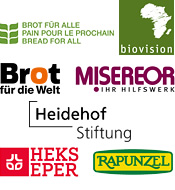Hunger in Times of Plenty
Victims of natural disasters such as drought and floods, or of conflict and civil war, make up the minority of people affected by hunger. The picture of hunger and misery painted by the media does not show the silent majority of those unable to lead a normal life due to a chronic lack of food. Undernourishment makes them too weak to learn and work normally, causes irreparable damages and makes those affected susceptible to infectious diseases and parasites.
Mothers and children in their first years of life are hit hardest by malnutrition. The 1000 days between a woman’s pregnancy and her child's second birthday are considered critical to the physical growth and brain development of a child. Every year, almost seven million children under five die; one third of them due to pneumonia, diarrhoea and malaria. UNICEF estimates that nearly half of them could survive with better nutrition. The number of children with stunted growth is even higher than that of underweight children. Stunting causes irreversible cognitive and physical damage, perpetuating the cycle of hunger and poverty in the next generation.
Hunger can only be overcome locally
More than 70% of the hungry live in rural areas. They are small-scale and subsistence farmers, pastoralists, fishermen, rural workers and landless people who directly depend on local land and water use. These rural poor frequently do not have secure access to sufficient amounts of food. Access to land, water and means of production, as well as training, know-how and a minimum of social protection in emergency situations determine in the first place whether or not their human right to sufficient and nutritious food is fulfilled. In second place, additional employment opportunities in rural areas are needed. Therefore, a central message of the IAASTD report is that hunger is primarily a rural problem that can only be overcome locally in the long term. Accordingly, regional self-sufficiency with food is, wherever possible, the essential backbone of sustainable rural development.
Misery and rural exodus
Over the past few decades, the situation of the rural poor in many regions of the world has deteriorated dramatically. Small-scale farmers have been displaced, their income has steadily decreased and their yields have stagnated. Especially in Africa, the HIV/AIDS epidemic has left millions of families and communities without their most active members and the burden of additional costs and extra work in order to care for the sick and orphaned. It is mostly young men who look for work in the cities, leaving women, children and the elderly behind, often in precarious situations. Rather than building up reserves for crises or crop failures, or producing surpluses they could sell to obtain money for necessary investments, they only manage to grow food for their survival.
Rural exodus is shifting hunger and poverty to the slums and suburbs of the growing mega-cities, where money is an even more decisive factor than in rural areas. For poor people who spend much of their income on food, already modest increases in food prices will have a dramatic effect. An explosion of food prices such as in the years 2008 and 2011 therefore caused thousands of people whose livelihoods were threatened to take the streets. Their hunger revolts, mainly in the capitals, contributed to the fact that governments in Asia and Africa today take self- sufficiency in food more seriously than at the time the IAASTD was adopted (see also food sovereignty).
A question of political will
In many of the hardest hit countries, weak governments at national and regional level frequently have other priorities than fighting hunger in the population. Humanitarian and development aid can even become an important source of income for those in power, who use the misery of their own people to their own advantage. The failure of many governments in the fight against hunger is often caused by corruption, incompetence, war and internal conflict. The arrogance and ignorance that urban elites display with respect to rural development present further problems. The erosion and collapse of state rule, especially in remote rural regions, often leads to local violence and exploitative structures in which little value is given to human life.








